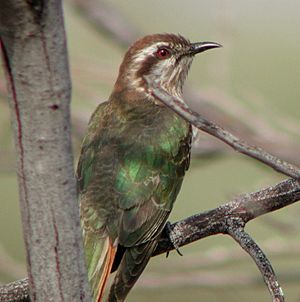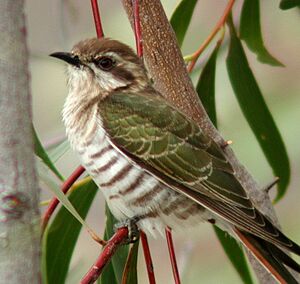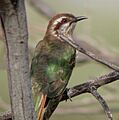Horsfield's bronze cuckoo facts for kids
Quick facts for kids Horsfield's bronze cuckoo |
|
|---|---|
 |
|
| Conservation status | |
| Scientific classification | |
| Genus: |
Chrysococcyx
|
| Species: |
basalis
|
The Horsfield's bronze-cuckoo (Chrysococcyx basalis) is a small bird from the cuckoo family called Cuculidae. It weighs about 22 grams. This cuckoo has shiny green and bronze feathers on its back. It also has brown stripes on its neck and tail. You can tell it apart from other bronze-cuckoos by its white eyebrow and a brown stripe near its eye. The Horsfield's bronze-cuckoo is common in Australia. It prefers dry, open woodlands instead of thick forests.
Contents
What is a Horsfield's Bronze-Cuckoo?
The Horsfield's bronze-cuckoo is one of five types of cuckoos found in Australia. These birds belong to a group called Chrysococcyx. They are known for being "parasitic" birds. This means they lay their eggs in the nests of other birds, usually fairy-wrens. The fairy-wrens then raise the cuckoo chicks as their own.
The five types of cuckoos in the Chrysococcyx group are:
- Black-eared cuckoo (Chrysococcyx osculans)
- Horsfield's bronze-cuckoo (Chrysococcyx basalis)
- Shining bronze-cuckoo (Chrysococcyx lucidus)
- Little bronze-cuckoo (Chrysococcyx minutillus)
- Gould's bronze-cuckoo (Chrysococcyx russatus)
Diet and Daily Life
Horsfield's bronze-cuckoos mostly eat insects. They are nomadic, which means they travel around Australia. They move to different areas to find food and to breed. They catch small insects from leaves and branches. Sometimes, they even catch insects while flying! During breeding season, male and female cuckoos feed each other. This is part of their courtship ritual.
This cuckoo is famous for being a brood parasite. This means the female cuckoo lays her eggs in another bird's nest. The other bird is called the host species. They mostly use fairy-wrens from the group Malurus. It is well known that the superb fairy-wren (Malurus cyaneus) and the splendid fairy-wren (Malurus splendens) are common hosts. They might also use nests of other small birds. These can include thornbills, warblers, and scrub-wrens.
Scientists think that female cuckoos choose their host by remembering. They remember the type of bird that raised them. Then, they choose that same type of bird to raise their own young.
Reproduction and Life Cycle
Horsfield's bronze-cuckoos often form pairs during the breeding season. They stay in the same areas as their host birds. However, these partnerships don't last very long. A female cuckoo might stay in a breeding area for only a few weeks. Then, another female might take her place. She might even pair with the same male.
A female cuckoo that leaves a breeding site might go to another area. There, she can find a new male and continue to breed. Cuckoo breeding areas usually do not overlap. This means a pair might defend their territory for the whole season.
Since they are brood parasites, Horsfield's bronze-cuckoos do not build their own nests. They use the nest of a host bird to lay their eggs. Their breeding season depends on when their host birds are breeding. They usually lay one egg. This egg looks very similar to the host's egg. It is a long, pinkish-white egg with red-brown spots.
The superb fairy-wren breeds from September to February. A female fairy-wren can have three groups of chicks during this time. This gives the cuckoo many chances to lay its eggs in their nests. A female cuckoo might choose a breeding site with many host birds. This increases her chances of successfully laying an egg. Studies have shown that some female cuckoos will not lay eggs in an area with fewer than 23 pairs of their main host, the superb fairy-wren.
The cuckoo's egg is small for its size. Over time, it has changed to look like the host's egg. This is like an arms race between the cuckoo and the host. The smaller the host bird, the more groups of chicks the cuckoo can have. This means the cuckoo can use its energy better to make more small eggs.
Horsfield's bronze-cuckoos lay their eggs very quickly. They can lay an egg in less than 6 seconds. This usually happens in the morning, soon after the host bird has laid its own egg. The adult cuckoo removes one of the host's eggs each time she lays her own. She only lays one egg per nest.
Younger, but experienced, female cuckoos are often chosen by males. This is because they have a better chance of success. Horsfield's bronze-cuckoos choose females who pick similar breeding sites each year. These females are also likely to have several groups of chicks in one season.
Usually, the superb fairy-wren does not reject the cuckoo's egg. Fairy-wrens build dome-shaped nests that can be dark inside. This makes it harder for the fairy-wren to tell its own egg from the cuckoo's egg. Also, the cuckoo's eggs have changed over time to look very similar. They are only slightly longer and a bit shinier.
The cuckoo chick hatches within 12 days. This is usually two days before the host's eggs hatch. Within two days of hatching, the cuckoo chick pushes the other eggs out of the nest. This leaves the cuckoo as the only chick. Young cuckoo chicks do not learn the host's begging call. However, they can make calls that sound like their main host. As the cuckoo chick grows, the host parents feed it. It grows very quickly until it is ready to fly.
The "Arms Race" Between Cuckoos and Hosts
Scientists have seen how both host birds and cuckoos adapt to each other. This is like a coevolutionary "arms race." Each species changes over time to deal with the other. Studies show these changes happen at all stages of their lives.
Fairy-wrens have developed ways to protect themselves from cuckoos. It takes a lot of energy for a host bird to raise a cuckoo chick. This high cost makes the host try to improve its defenses. This, in turn, makes the cuckoo try to improve its ways of laying eggs.
Here are some ways host birds defend themselves:
- Hosts like to nest in large groups. This helps them work together to spot cuckoos and chase them away.
- Other birds in large groups help feed the female host. This lets her spend more time guarding the nest.
- Hosts learn to recognize their own eggs. They might abandon any eggs that are in the nest before they start laying their own.
Here are some ways cuckoos adapt:
- Their eggs look like the host's eggs.
- Their eggs are hard to see in the dark nest.
- Their egg shells are thicker.
- They are very fast at laying eggs. They can lay an egg secretly and quickly when the host bird is not there.
Images for kids
See also
 In Spanish: Cuclillo de Horsfield para niños
In Spanish: Cuclillo de Horsfield para niños




